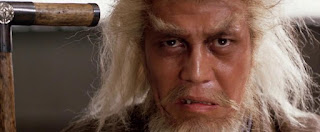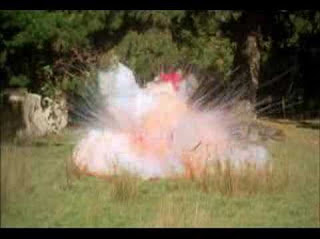Halloween (1978)
Tagline: ’The night HE came home’Running Time: 91 minutes (Theatrical Version), 102 minutes (TV/Extended Version)
Film Quality: 5/5
Gore Content: 1/5
Entertainment Value: 5/5
Originality: 4/5
Introduction
Some films really don’t need an introduction!
In a Nutshell
After murdering his sister at the age of just six years, Michael Myers spends the next 15 years in a sanitarium under the care of Dr Loomis. Shortly before the anniversary of the fatal stabbing, Myers escapes and heads for his home town of Haddonfield to pick up where he left off and target more teenage victims on Halloween night.
So, what’s good about it?
‘Less is more’! Some of the truly great horror films leave more to the imagination knowing that what’s going on in your head is far worse than anything that could take place on screen. Do you remember when you were young, afraid of opening your bedroom door when it was dark? There was nothing behind it that could possibly hurt you, you knew that but because it was dark you imagined that there might, possibly be something unnatural on the other side, in the dark. That’s how ‘Halloween’ works. No blood, you only ever catch a glimpse of Myers’ face, the film is steeped in shadow…everything is just off screen but you know that at any moment that door will be pulled wide open and you’ll be face to face with the bogey man (or ‘Boogeyman’ for our American friends) and your fate will be sealed.
John Carpenter’s direction is absolutely impeccable and he cranks the tension up to eleven throughout the course of the film. He unwittingly created a number of tropes that have been done to death to give us some monumental scares. The ‘terrible place’ which is the Myers home, a house where something dreadful happened (the original Myers murder) resulting in the house being abandoned and branded haunted. The terrorisation of the ‘final girl’, her vulnerability causing us to fear for the safety of the only character we now empathise with. The fluid ‘point of view’ camera creating the illusion of an omnipresent evil. Characters who drink, have sex or do drugs are murdered for their sins whilst the ‘virgin’ is pure and is able to defeat or deflect the vengeful redeemer. This is where it started.
Carpenter was reportedly so confident of the project that he rescinded any fee, taking only $10,000 for writing, directing and scoring the movie – as well as retaining ten percent of the profits, a genius move that made him a millionaire. He wrote the script in ten days, shot it in just 20 days on a budget of $300,000 which is an astonishing achievement. Carpenter had such a tight control of the movie, keeping the continuity going by introducing a fear meter so that characters would know (it was shot out of sequence to maximise shooting time) at what stage of fear and tension they were required to be.
The art direction and lighting is central to the movie, becoming part of Myers’ character make up as he bases himself in the shadows. You think you’re seeing something from his point of view until you see him move out of the shadows. He’s dressed in black with a white mask allowing him to blend into the night (try watching the film in black and white – it’s just as, if not more effective than in colour!). The mask is a likeness of William Shatner spray painted white and that emotionless, featureless face is so terrifyingly effective, especially the scene where he stabs one victim before stepping back and tilting his head as if admiring a work of art.
Of course there’s the wonderful Jamie Lee Curtis (right), scream queen extraordinaire and daughter of Janet Leigh who’s infamous for being the first victim of Norman Bates in ‘Psycho’. What could have simply been a great bit of movie trivia or PR began a fantastic sequence of scream queen performances I ‘Prom Night’, ‘Terror Train’, ‘Halloween 2’ and of course working with Carpenter again in ‘The Fog’. She’s the human heart of the film, the one we cheer for and her sweet innocence and studious nature ensures that she wins us over immediately. Of course she’s gone on to become a screen legend in her own right, being equally at home as an action heroine, comedy actress and in more serious fare. She also recalls the film with fondness in documentaries which is pleasing.
And staying with acting who can forget Donald Pleasance (left) as Dr Sam Loomis. I find it interesting that this element hasn’t turned up in any other slasher film that I can think of. It lends the film a certain credence that other such genre films don’t have, a glimpse into Myers’ psyche that we haven’t seen since. Apparently Peter Cushing and Christopher Lee turned down the role but Pleasance nails it. He has an intensity that is underpinned by a vulnerability and knowing that he simply cannot stop the evil. Subsequent slashers would reduce his role to a janitor or petrol pump attendant as the ‘harbinger of doom’, the one who knows the evil and warns them of its power but those damn fool kids think they know better. It grounds the film in reality as well…a character as insane as Myers would surely have a psychiatrist by the time they’re an adult!!!
What about the bad?
It’s pretty much the perfect horror film and so influential that it inspired countless imitations, but there’s more on that later. At the time of release it certainly had its critics, many accusing Carpenter of misogyny. I’m not sure that really holds up. The main criticism was that the violence towards women lingered more than the violence against the male characters. I’m pretty sure it was one of the male characters that Myers stabs with a knife, pinning him up against a door before standing back to admire his work (see below). In fact of the five people murdered, two are male characters and it is left to the final female character, Laurie, to turn the tables on Myers and fight back. Yes, it’s Loomis who eventually comes in, guns blazing who saves Laurie, but it’s a temporary relief…Laurie is the heroine of the film and the only one string and capable enough to muster any kind of defence.
My only sadness about ‘Halloween’ is that the number of pale imitations may have dulled the impact for those approaching the film with fresh eyes. Pretty new at the time, only a few ‘slashers’ (‘Texas Chain Saw Massacre’, ‘Black Christmas’, ‘Bay of Blood’) had been made before and weren’t really categorised as such, but it was Carpenter’s film that laid the blueprint. Blood and gore are the order of the day in modern day slashers and with this aspect lacking from ‘Halloween’, would it hold the interest when presented with scenes and situations that will have been seen many times before from inferior films? Perhaps I’m just getting old but for the ‘Scream’ generation (as an aside, I loved Craven’s film!), is this film too old fashioned for today’s kids?
Release History
No blood, very little nudity and any sex was off screen so there was nothing really to cause any censorship issues. There were some additional scenes filmed for a TV version which has since become known as the ‘Extended Version’ and released alongside the theatrical version as a special edition blu-ray.
Any Themes?
We’ve touched on some of the themes already but ‘Scream’ laid some of the issues on the line pretty well, one of which is the punishment of youth, particularly irresponsible behaviour. The original premise of the film was a serial killer who preyed on babysitters, some of which was retained. Michael kills his sister, Judith, for preferring to have sex (the very quickest of ‘quickies’!) rather than looking after her younger brother. As she is the one responsible for her brother’s welfare, she is the one punished rather than her boyfriend. We later see other characters, some sexually promiscuous, killed for their ‘sins’ which also includes drinking.
Taking this to its logical conclusion, Laurie survives because she doesn’t have sex, doesn’t drink and fulfils her role as the carer, in this case a babysitter. Because she has her wits about her and is able to ‘see’ - she is the only character aware that there is a killer on the loose, spotting the danger and being able to protect Tommy and Lindsey. This is a frequent character trait of the ‘final girl’ – presumably not drinking, taking drugs or participating in sex means there are no distractions, making them aware of the presence of a threat and being able to deal with it. Those ‘distracted’ by sin, are not and pay the ultimate price.
Most slashers are ultimately morality tales…there are some where the ‘final girl’ is a teenage boy who doesn’t act like an alpha male and a few others where the killer is female. The victims however remain the same and designed to be as disposable as possible – foreshadowing is not the strong point of your average slasher film!
Cultural Impact
‘Halloween’ spawned an entire sub-genre of horror films. For the terrible place, in this case the Myers house, you can reference Camp Crystal Lake or Freddy’s boiler room. For Myers you can read Jason Vorhees, Cropsy or Freddy. For every kitchen knife you have a chainsaw, a machete or a power drill – guns don’t work, only tools and implements designed to penetrate. They’re all the same and took their cues directly from ‘Halloween’.
As a film series it spawned six sequels and two remakes, all elaborating on the Myers character and, in the case of ‘Halloween: H20’ returned to Laurie’s character to give us a glimpse of what a horror film survivor may have ended up like.
Final Thoughts
It’s hard to do justice to a film like ‘Halloween’ in a relatively short blog post. Everything that could be said or written about it has already been committed to print and film and summing it up in this way makes it sound like every other slasher film that has ever been made. But that’s the point, every other slasher came AFTER ‘Halloween’, one of the most profitable independent films of all time let’s not forget at a budget of just $300,000 and a box office of around $70million, plus who knows how much since in VHS, DVD and Blu-Ray sales. It’s an incredible success story and a testament to everyone involved who believed in this little low budget chiller that continues to take the world by storm.
Memorable Quotes
Sheriff Blacket: “It’s Halloween, everyone’s entitled to one good scare.”
Loomis: “I watched him for fifteen years, sitting in a room, staring at a wall, not seeing the wall, looking past the wall, looking at this night, inhumanly patient, waiting for some secret, silent alarm to trigger him off. Death has come to your little town.”
Annie: “Poor Laurie, scared another one away.”
Loomis: I met this six year old with this blank, pale, emotionless face and the blackest eyes, the devil’s eyes. I spent eight years trying to reach him and another seven trying to keep him locked up because I realised that what was behind that boys eyes was purely and simply evil.
You’ll like this if you enjoyed…
‘Friday the 13th’, ‘A Nightmare on Elm Street’, ‘The Burning’, ‘Scream’.





































